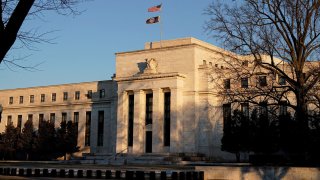
Mark Twain once noted that news of his death was greatly exaggerated.
In the case of inflation, that news may be an understatement, despite today's sudden worries that rapid price increases may live on forever.
There has been a complete collapse in a wide variety of inflation indicators. Indeed, financial markets have now shifted from worrying about inflation to anxiety about recession.
Everywhere I have looked, market-based indicators have suggested that inflation, as an economic issue, is on life-support.
Let's begin with inflation expectations.
Get Connecticut local news, weather forecasts and entertainment stories to your inbox. Sign up for NBC Connecticut newsletters.
Plunging breakevens
Five-year "inflation breakevens," a bond market measure of future inflation expectations, have plunged more than a full percentage point since peaking at 3.59% in late March.
Bond yields, themselves, have tumbled at both the long and short ends of the Treasury yield curve.
Money Report
The 10-year note yield is back below 3%, while two-year yields have plummeted to 2.86% on Friday from 3.42% just two weeks.
Looking elsewhere, commodity prices, excluding crude oil, have also declined sharply.
- Copper is down 27% from its most recent high.
- Soybeans are down 18%.
- Wheat, despite the war in Ukraine, is down 31%.
- Natural gas, also despite the war, is down over 38%.
The San Francisco Federal Reserve recently released a study supporting an argument that I have been making for months … that inflation pressures are more the result of pandemic- and war-related supply chain disruptions than excess demand.
The study shows that 2.4 percentage points of the jump in today's inflation is attributable to supply disruptions of raw materials and finished goods while 1.4 percentage points of the increase in inflation comes from excess demand.
In other words, the Federal Reserve's rate hikes will only affect a single factor driving the inflation spike and have virtually no impact on the others … effectively weakening the economy for no good reason, in my humble opinion.
Wringing out speculative excess
The good that has come from the Fed's tighter policies is to wring speculative excesses out of the financial markets from retail investors creating wild valuations in "meme stocks," to extreme overvaluations in stocks, writ large, and in the Wild West activity taking place in cryptocurrencies.
That's something that will likely return rationality and longer-term stability to financial markets, broadly speaking.
However, the downside has also had negative consequences for an economy that has maintained high levels of employment and returned some bargaining power to labor.
Still, in addition to market-based indicators, we've seen tighter Fed policy have a pronounced effect on the real economy and real people.
Housing sales have fallen through the floor.
There have been notable declines in manufacturing activity, while there has also been a reduction in both shipping costs and delivery times.
All those items suggest that inflation will abate soon and will reduce the price of finished goods.
Retail spending has slowed, and growth forecasts have declined at home and abroad.
The Atlanta's Fed's GDP Now estimate for the second quarter just turned negative, projecting a 1% contraction in gross domestic product.
That would mark the second quarter of negative economic growth in the U.S., meeting the technical definition of a recession, even if large sub-sectors of the economy, such as employment, do not bear that out.
The Federal Reserve, the European Central Bank, and other central bankers this week, again voiced their unwavering commitment to snuffing out the inflation wildfire and not allowing it to grow into the type of persistent price increases that wreaked havoc on the economy from the late 1960s through the early 1980s.
Inflation's death this time, however, may not be exaggerated.
Central banks have done enough to simply let it rest in peace.
— Ron Insana is a CNBC contributor and a senior advisor at Schroders.






